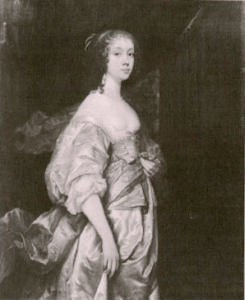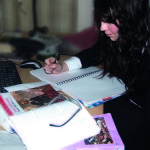Margaret Cavendish, Duchess of Newcastle, c 1623-1674
Table of Contents
Playwright; poet; natural philosopher. It was famously said of Margaret Cavendish that she was different to the rest ‘of her frail sex’ who, unlike her, ‘have Fruitful Wombs but Barren Brains’.
Gender in the seventeenth century
The task of reconstructing women’s lives in the seventeenth century can be fraught with problems. Many records were lost in the English Civil War and, as in other centuries, women are harder to trace as they leave less of a trail than men. To find evidence of men’s careers historians can look to written records such as lists of workers, businesses, students, holders of public office, titles and so on, but women (especially ones from more humble backgrounds) leave no such account of themselves from their setting in the domestic sphere.
Yet from the evidence that has emerged it seems that some women at least were questioning their allotted place in society, and that there was much debate about gender roles at the time. In the seventeenth century, the idea of women’s inferiority—her status as the ‘weaker vessel’— was based on arguments from Christianity and the Bible. Theologians looked to the Genesis story to argue that man was made in the image of God, woman was not and, therefore, she was imperfect. What’s more, it was Eve who had succumbed to temptation and caused the expulsion of man from the Garden of Eden, so her moral strength was far below that of a man’s too. This, and women’s ‘natural’ role as wife and mother, became a reason for not giving her the same educational opportunities as her brothers. And, once women appeared ‘stupid’ through lack of education, it was easy to move to arguing that since women were ‘stupid’ they were not worth educating.
These were the views that Margaret Cavendish, Duchess of Newcastle, argued against with a passion. She was a vocal advocate of change and, exploiting her privileged social position, she sought through her writing and scholarship to open up opportunities for women and to become the equal of the learned men of her day.
Given her philosophical and scholarly interests, Margaret would have had more luck if she had been born one hundred years earlier. Then, for a brief time, women had enjoyed a fuller life (perhaps inspired by the reign of the highly-educated Elizabeth I). For example, Lady Jane Grey was very learned, as were the daughters of Sir Thomas More and women of other noble families. These opportunities began to disappear in the early-seventeenth century however, as girls became more commonly schooled in fashionable accomplishments rather than the mathematics, Latin and Greek needed for serious study. The few charity schools for poorer women were really a place to train for domestic service. What’s more, the Dissolution of the Monasteries in the sixteenth century had removed the religious institutions which had provided some girls with serious educational opportunity, and an outlet for their skills and intellect.
Brief biography

Portrait of Margaret Lucas, believed to be by Sir Peter Lelys, c 1635
Margaret Cavendish was born Margaret Lucas in Colchester, in 1623 or thereabouts. Her oldest brother was born out of wedlock as her father, Thomas Lucas, was banished for duelling, delaying his marriage to Margaret’s mother, Elizabeth Leighton. The family, like many other Royalists, lost their home and fortune during the Civil War. When she was twenty years old, Margaret became a lady- in-waiting to Queen Henrietta at the displaced Royal Court at Oxford. She accompanied the Queen into exile in Paris where she met William Cavendish, Earl of Newcastle. He soon noticed Margaret and began a courtship which eventually led to marriage. He was considerably older and had been married before; despite this their union is usually considered a love-match.
Margaret was fortunate in being able to choose her own husband. Girls, especially of aristocratic birth, were still sometimes promised in marriage soon after their birth, and marriage at the age of twelve, thirteen or fourteen was not uncommon. Young brides were often transferred to their ‘in-laws’ homes to be brought up. Also, Margaret had been rendered ‘dowerless’ by the war, something which could have seriously damaged her chances of marriage.
However, Margaret’s marriage was not without its problems. Cavendish was a well-known royalist and his estates were sequestered leaving him in financial difficulties. In addition, Margaret failed to conceive and the couple had no children (although Cavendish had five children from his previous marriage). She later identified her need to write variously as a ‘disease’, an ‘addiction’ and a ‘child substitute’, calling her books ‘paper bodies’. From the beginning of her marriage Margaret wrote, and published, her work often received with scepticism if not downright hostility. She was particularly vilified for her audacity; to write with the express intention of publication was very daring for a woman (to do so was to expose yourself to public view, a taint on a woman’s chastity). Margaret is credited with being the first woman who wrote for publication in England; a self-conscious writer who published eleven books and two collections of plays.
Margaret died in December 1673 and is buried in Westminster Abbey.
Plays, poems, philosophical writings
Love’s Adventures (1662)
Poems and Fancies (1653)
Philosophical Fancies (1653)

Frontispiece of The World’s Olio, 1671 edition, engraved by Abraham van Diepenbeke, showing Margaret Cavendish in her closet.
The World’s Olio (1655) (An ‘olio’ is a stew; this was a collection of various observations and reflections on different subjects)
Philosophical and Physical Opinions (1655) This was a work of materialist natural philosophy. It also included an address ‘To the Two Most Famous Universities of England’ which was a passionate (and personal) plea concerning women’s lack of educational opportunity. She called for
…the good encouragement of our sex, lest in time we should grow irrational as idiots, by the dejectedness of our spirits, through the careless neglects and despisements of the masculine sex to the female, thinking it impossible we should have either learning or wit or judgment, as if we had not rational souls as well as men, and we out of dejectedness think so too, which makes us quit all industry towards profitable knowledge, being employed only in low and petty employments, which take away not only our Abilities towards arts, but higher capacities in speculations, so we are become like worms, that only live in the dull earth of ignorance, winding our selves sometimes out by the help of some refreshing rain of good education, which seldom is given us, for we are kept like birds in cages, to hop up and down in our houses…
Grounds of Natural Philosophy (1668)
Nature’s Pictures (1656) Mostly verses, and prose, on the subject of love, which also considers issues of sex and gender. This was also a major theme of her next two works
Plays (1662)
Orations of divers sorts (1662)
Sociable Letters (1664)
Philosophical Letters (1664)
Observations upon Experimental Philosophy (1666)
The Description of a New World, called the Blazing World (1668). This is the only known Utopian fiction by a seventeenth century woman. The narrative, which revolves around a powerful woman, symbol of femininity, engages with questions that were central to natural philosophy (science) at the time. Here Margaret offers a critique of Francis Bacon’s The New Atlantis which was a scientific treatise providing an alternative way to understand nature and to control it. In both ‘new worlds’ (Bacon’s and Margaret’s), scientific research is a priority and how we understand and interpret nature are central ideas. Margaret argues that modern philosophers were arrogant if they thought that they could know and control nature; in particular she criticises Robert Hooke, countering his claim in Micrographia (1665) that with the aid of new technologies such as the microscope man can gain power over natural causes and effects.
The Life of William Cavendish (1667)
Plays Never Before Printed (1668)
Reception and reputation
Margaret became known as ‘Mad Madge’, because of her daring to be a woman writer, engaging in philosophical debates with men, and because of her theatrical sense of dress. Samuel Pepys wrote that she was ‘ridiculous’; the response of Dorothy Osborne was typical:
Let me ask you if you have seen a book of Poems newly come out, made by my lady Newcastle. For God’s sake if you meet with it send it me, they say it is ten times more Extravagant than her dress. Sure, the poor woman is a little distracted, she could never be so ridiculous else as to venture at writing books—and in verse too. If I should not sleep this fortnight I should not come to that.
Margaret Cavendish’s attempts to engage with the world of seventeenth-century natural philosophy (science) was received with similar disdain. Her advantages of rank did not outweigh the disadvantages of her sex. The centre of the new science was the newly-founded Royal Society of London, and this did not admit women. Margaret did visit the Society, in 1667, and watched scientific demonstrations by Robert Boyle, Robert Hooke and others. However a brief visit was the most that the men of the Royal Society would entertain. Had she been a man, Margaret would have been a likely candidate to become a Fellow, having written extensively on natural philosophy (men of her high birth were allowed to join without going through the usual vetting procedure). Pepys records that most fellows thought that if she were admitted this would invite ridicule and lower the Royal Society’s status. No woman was elected to full membership of the Royal Society until 1945.
Today Margaret is seen as as important a writer and natural philosopher as many of her male contemporaries. Typical for a woman, she was largely self-taught and some historians have suggested she may have been dyslexic. She certainly offers a thought- provoking critique of gender relations that predates Mary Wollstonecraft’s by over one hundred years.
Virginia Woolf, in A Room of One’s Own, wrote of ‘hare-brained, fantastical Margaret of Newcastle’ and exclaimed
.. what could bind, tame or civilise for human use that wild, generous, untutored intelligence? It poured itself out, higgledy-piggledy, in torrents of rhyme and prose, poetry and philosophy which stand congealed in quartos and folios that nobody ever reads. She should have had a microscope put in her hand. She should have been taught to look at the stars and reason scientifically. (Panther Books, 1980, p. 59)
Like Woolf after her, Margaret Cavendish explored and analysed woman’s lot, questioning women’s inferior status. She thought that women were excluded from public life and learning merely by ‘use and custom’, and she wrote funny and piercing satires to demonstrate her view. Women were kept in their homes, in Margaret’s words, ‘like birds in cages’, only through lack of education, prejudice, tradition and their own ignorant apathy. Her analysis still has application today.
Further Reading
Margaret Cavendish, The Blazing World and Other Writings (Penguin Classics)![]()
Bowerbank and Mendelson, eds, Paper Bodies: A Margaret Cavendish Reader (Broadview Literary Texts Series)![]()
Kathleen Jones, A Glorious Fame: The Life of Margaret Cavendish, Duchess of Newcastle, 1623-1673![]() , Bloomsbury (1988)
, Bloomsbury (1988)










Leave a Reply